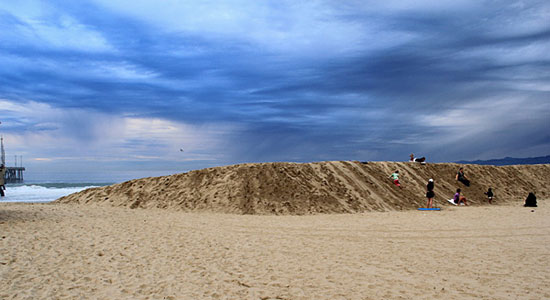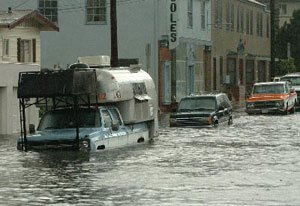Charting a sea change
March 20, 2014
Hotter heat waves in the Valley. Smaller snowcaps in the mountains. Worse flooding during storms on Pacific Coast Highway. Study by study, local scientists are gradually pinpointing the ways in which climate change could impact Southern California. The news has been sobering.
Now, the county is preparing to zoom in on another piece of the picture, with a look at rising sea levels at the 21 beaches it operates and maintains. Approved this week by the Board of Supervisors and funded in large part by a grant from the California Coastal Conservancy to the county Department of Beaches and Harbors, the $86,815 study will run from April to October, and add to a growing body of work on the local impact of climate change.
“There have been broad projections about what sea level rise might look like, but that picture isn’t specific enough for what planners and policy makers need,” says Megan Herzog, a fellow at the UCLA law school’s Emmett Center on Climate Change and the Environment.
Although the City of Los Angeles has made some headway, most notably with a recent study on the potential impact of sea-level changes along the city’s coastline, “most local governments are just at the data gathering stages,” says Herzog. “So we’re really just at the beginning of thinking about impacts and making plans.”
With more than 52 million visitors a year just at the beaches that are county-owned or -managed, a full assessment of the coastline’s vulnerability is critical both to the environment and to the economy, says Kerry Silverstrom, chief deputy director at Beaches and Harbors.
“One study found that sea levels on the West Coast have risen twice as fast over the last five years as they did over the last twenty,” says Silverstrom, noting that the sea level is projected to rise by up to two feet by 2050. “So we need to look at what are we going to do as operators of the beaches to protect them?” she says.
Higher tides not only can flood low-lying buildings and roads, but can also exacerbate storm damage by undermining parking lots and damaging coastal sewer lines. These issues are of particular importance on the county-maintained and operated beaches, which range from Royal Palms in the South Bay to Malibu’s Nicholas Canyon, and include such landmarks as Marina Del Rey, Point Dume and Venice Beach.
The city’s January sea level study, done in cooperation with USC, found that the Port of L.A. and energy facilities along the coast were in good shape to withstand the impact of rising sea levels. However, low-lying communities such as Wilmington, San Pedro and Venice are especially vulnerable, as is Pacific Coast Highway, which already floods regularly in some places when winter storms hit.
The study found that even a moderate storm could do more than $400 million in damage on the city’s share of the beaches if the sea level were to rise here by just 18 inches or so, a mark that easily could be reached by 2050. Also at risk are wastewater and drinking water systems near the high tide line.
Charlotte Miyamoto, head of the planning division at Beaches and Harbors, says the county’s research will have big implications for county public works projects such as sea walls and sand berms—protective structures that the county uses to prevent crashing waves from scouring beaches, undermining parking lots and flooding Pacific Coast Highway.
Although critical in mitigating the ocean’s impact on infrastructure on which the public relies, residents in Venice and Marina Del Rey have complained that the temporary berms, in particular, block their view of the ocean—a complaint that seems likely to be amplified as rising sea levels raise the risk of damage from storm surges.
“How big and wide will we need to make those berms?” says Miyamoto. “Will we want to build structures in the water to deal with erosion? The beaches are our first line of defense as the sea level rises,” says Miyamoto, “and so we want to make sure they’re preserved.”
More broadly, the county study also will help focus policy choices, says Herzog. Already, she noted, coastal cities elsewhere in California are moving bike paths and other amenities away from narrowing beaches and rising tides.
“This region is really densely developed along the coast,” she says. “In some cases, we have development right up along the backs of beaches, and that’s going to mean we have to think about priorities. We have to decide if it’s important to preserve beaches and wetlands and ecosystems, for instance. And if it is, then it’s going to mean tough decisions about development up and down the coast, and it could mean major changes in land policy over the long term. Because something has to move.”
Silverstrom noted that the Beaches and Harbors study, while narrow, is just one part of a broad effort the county has been undertaking for the past two years to prepare for climate change. A series of climate change studies led by the UCLA Institute of the Environment and Sustainability has projected, among other things, that average annual temperatures in Greater L.A. will rise by an average of 4 or 5 degrees by 2050, that days of extreme heat will quintuple in inland areas and the valley and that the area’s mountains will get about a third less snowfall.
So, acting on a 2012 motion by Supervisors Zev Yaroslavsky and Michael Antonovich, county departments across the board have been assessing the potential impact of climate change and trying to mitigate its potential costs.
The county Fire Department, for instance, has revised training protocols to account for the warming climate. The Internal Services Department has been working to reduce the carbon footprint at county buildings and to improve energy efficiency. The Department of Public Works, meanwhile, has been trying to capture more storm water, and to replace gas-fueled trucks with more eco-friendly vehicles.
Silverstrom of Beaches and Harbors says the latest study will help pave the way for short, medium, and long-term solutions to rising sea levels, coastal erosion and more powerful storms in the future.
“This is about resilience,” she says, “about how we can sustain our beaches for the public while recognizing what’s happening in the environment.”














 405 bridge work causes a stink
405 bridge work causes a stink
